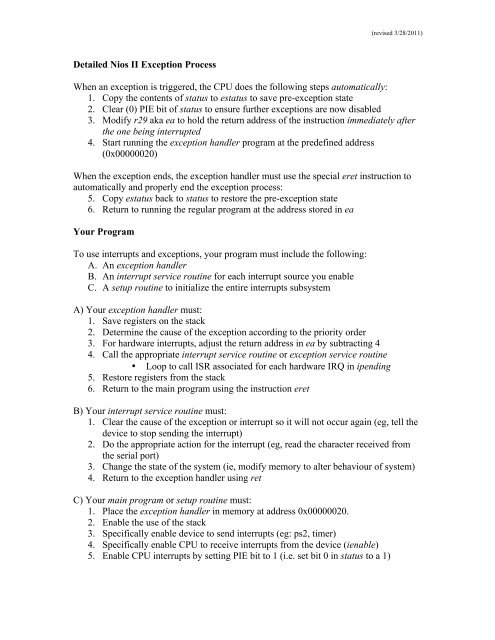L33-L38 Nios II Interrupts without LQuiz - Courses
L33-L38 Nios II Interrupts without LQuiz - Courses
L33-L38 Nios II Interrupts without LQuiz - Courses
Create successful ePaper yourself
Turn your PDF publications into a flip-book with our unique Google optimized e-Paper software.
Detailed <strong>Nios</strong> <strong>II</strong> Exception Process<br />
(revised 3/28/2011)<br />
When an exception is triggered, the CPU does the following steps automatically:<br />
1. Copy the contents of status to estatus to save pre-exception state<br />
2. Clear (0) PIE bit of status to ensure further exceptions are now disabled<br />
3. Modify r29 aka ea to hold the return address of the instruction immediately after<br />
the one being interrupted<br />
4. Start running the exception handler program at the predefined address<br />
(0x00000020)<br />
When the exception ends, the exception handler must use the special eret instruction to<br />
automatically and properly end the exception process:<br />
5. Copy estatus back to status to restore the pre-exception state<br />
6. Return to running the regular program at the address stored in ea<br />
Your Program<br />
To use interrupts and exceptions, your program must include the following:<br />
A. An exception handler<br />
B. An interrupt service routine for each interrupt source you enable<br />
C. A setup routine to initialize the entire interrupts subsystem<br />
A) Your exception handler must:<br />
1. Save registers on the stack<br />
2. Determine the cause of the exception according to the priority order<br />
3. For hardware interrupts, adjust the return address in ea by subtracting 4<br />
4. Call the appropriate interrupt service routine or exception service routine<br />
• Loop to call ISR associated for each hardware IRQ in ipending<br />
5. Restore registers from the stack<br />
6. Return to the main program using the instruction eret<br />
B) Your interrupt service routine must:<br />
1. Clear the cause of the exception or interrupt so it will not occur again (eg, tell the<br />
device to stop sending the interrupt)<br />
2. Do the appropriate action for the interrupt (eg, read the character received from<br />
the serial port)<br />
3. Change the state of the system (ie, modify memory to alter behaviour of system)<br />
4. Return to the exception handler using ret<br />
C) Your main program or setup routine must:<br />
1. Place the exception handler in memory at address 0x00000020.<br />
2. Enable the use of the stack<br />
3. Specifically enable device to send interrupts (eg: ps2, timer)<br />
4. Specifically enable CPU to receive interrupts from the device (ienable)<br />
5. Enable CPU interrupts by setting PIE bit to 1 (i.e. set bit 0 in status to a 1)

















